| |
|
Tahtib
Egypt's 5,000 Year Old Secret Art |
|
In November 2016
UNESCO Recognized Tahtib as an 'Intangible Cultural Heritage of Egypt' |
|
Tahtib now has the International Backing to ensure
the Ancient Art cannot be 'Appropriated by Any Other Country'
And its Heritage will be 'Maintained for Years to Come'
And Martial Arts Enthusiasts can learn this 'Discipline of Staff
Fighting' |
|
The Drums Beat a Hypnotic Rhythm - The fighters,
each armed with a bamboo-like rod, display their footwork as they keep
an eye on their opponent, accelerating or slowing down in time with the
music. They move in circles around one another, often in duels between
two, sometimes three or four at a time. |
|
Tahtib has Military Origins |
|
Originally, the ultimate goal was to "Destroy the
Other Person's Head"! |
|
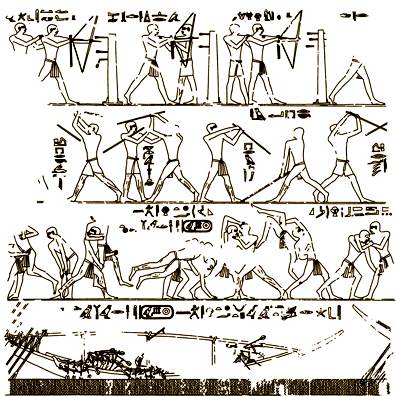 |

Based on these Pharaonic Engravings
(left & enlarged above)
It is now believed that Tahtib was one of three
disciplines for the Ancient Egyptian Army: Archery, Wrestling and
Fighting Using Staffs and/or Rods. |
Although the ancient military training disappeared from the Egyptian
landscape long ago, the Art has itself remained ingrained in the culture
across the southern rural areas.
Gradually it was transformed to become a game. A rural game played in
the evenings.
In Egypt you have at least four or five hours after the work [day]
because the sun set is very fast, and no television, so people used to
stay together to chant, to have poetry and to play music, and also with
the stick; just to play with the stick, so it became a rural game. The
rods that are used today are lighter, and unable to inflict the same
harm. |
|
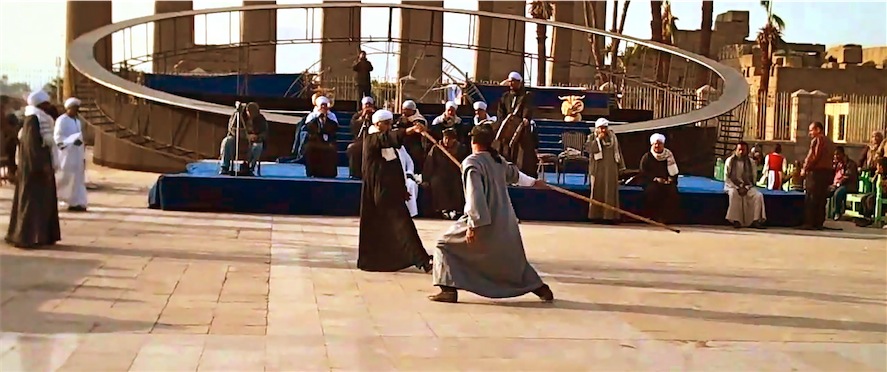 |
It has remained a pastime for men in the rural areas passed down
through the family. This was a traditional transmission from the father
to the son, the uncle to the son, the grandfather to the son. This is
now disappearing because there is no more traditional transmission.
At one point nearly 85 percent of the country lived in rural villages,
versus roughly 15 percent today.
To the common Egyptian, knowledge of stick fighting is associated with
the culture of the 'Fellahin': the peasants. It is also associated with
the folkloric dance that made a resurgence during the 1960s.
Together, were fused elements of Tahtib along with Baladi or
Egyptian Folk Belly Dancing that made its way into live performances
and films. One of their famous dances involved a stick, which is why
many people from that generation associate Tahtib with dance. |
|
Apart from those living in the villages, no one
really knew about the true Tahtib |
When you look at the other Martial Arts, you will discover then in
each culture you have what you call a form. In Japanese it's called 'Kata'.
He explains the same phenomenon is also found among the Martial Arts in
Korea, China and Indonesia. In all the forms, there exists a sequence of
movements that includes rotation, distance, and so on.
It was this structure that was lacking in Egypt. |
|
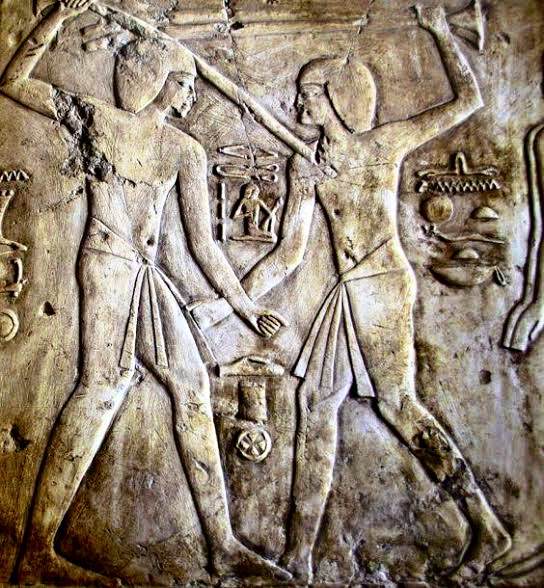 |
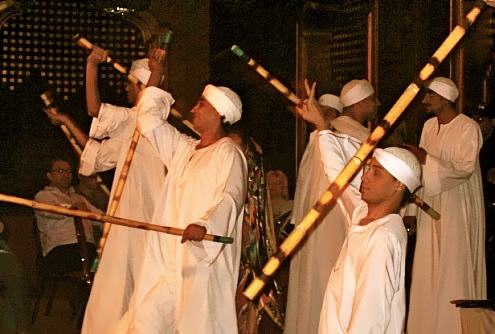 |
All the participants move in synchronization to the beat of the
music. It's almost like a choreographed dance, except each person is
armed with a stick, and uses the movements to access his or her
opponent.
Much like Brazilian Capoeira that moves to music as well, in Tahtib the
"music is here to kind of moderate or modulate the game to boost it, to
catalyze it if it's too slow, or calm it down if it is too tough, and it
links the game to the crowd.
As the combatants encircle each other, deliberating their next step, the
music slows down and the crowd claps in rhythm to the drums, adding to
the suspense of the match. |
|
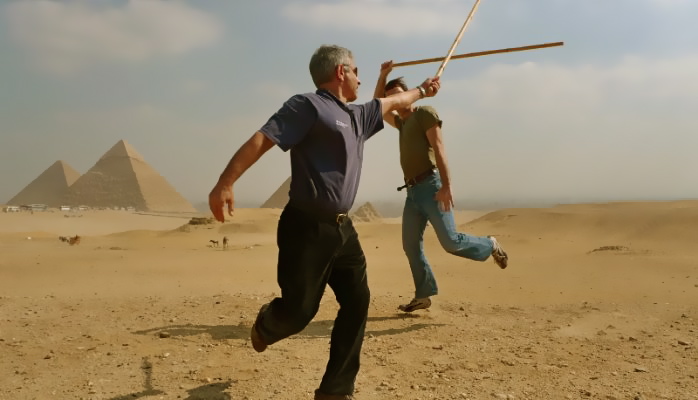 |
Music aside, part of the Art of Tahtib is also mastering the stick.
Right from the onset of training, participants are taught how to develop
control and power of the stick. The maneuvering of the stick sets up the
defense and offense between the combatants. The sound of the clank -
clank as the sticks hit each other are done in a rhythmic fashion as
well.
Competitions were never held, apart from a display of fighting as part
of a cultural festival in the Egyptian city of Luxor.
While the traditional dress, still found in the villages, is no longer
worn by the modern competitors, a red sash around the waste is required
by all those training and competing in Tahtib, as it resembles a similar
belt seen in the ancient engravings. |
|
The Kung Fu Nuns Assisting Nepal
Following Earthquakes |
Nepal has been Devastated in a Matter of a Few
Weeks!
More than 8,000 People Died after the Country was Rocked on April 25th,
2015, by a Magnitude 7.9 Earthquake
Nepal then Endured yet Another Major Earthquake - This one of Magnitude
7.3
Between the Two Quakes - Aftershocks, and Heavy Rainfall made Recovery
Efforts Difficult |
|
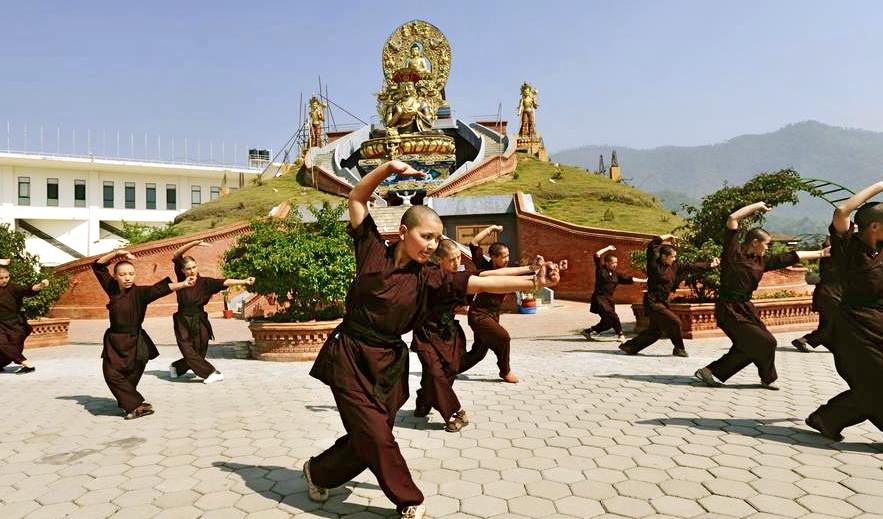 |
But amid this tragedy, some unlikely heroes have emerged: the
so-called "Kung Fu Nuns". These Buddhist Nuns of the Drukpa Order
live on the outskirts of Kathmandu at the Druk Amitabha Mountain
Nunnery, where they have incorporated the Martial Art into their
Buddhist practice. Three hundred of these Nuns refused to be evacuated
after the April quake in order to stay and help with recovery efforts.
When their Nunnery began to crumble during that first Earthquake, "the
Nuns jumped through shattered glass windows, smashed open rattling doors
and dived over a collapsing staircase," the Washington Post reported.
"They have been training for about four years to react with just such
speed and agility."
After tending to their Monastery, the Nuns have dedicated their time to
helping others in nearby villages. They do everything from removing
rubble to clearing paths. They distribute food, too, and help erect
tents to provide shelter for the millions of Nepalis who are now
homeless.
Wait... where did they come from? Traditionally, Buddhist Nuns
are trained in simplicity and expected to perform domestic chores in
Nunneries and Monasteries. Roughly 26 years ago, taking issue with the
inherently patriarchal and sexist Buddhist Monastic framework, members
of the 800-year-old Drukpa Order rebelled to form the more feminist
Druk Amitabha Mountain Nunnery. They took that goal a step further
in 2008, when their leader, Gyalwang Drukpa, introduced Kung Fu to the
nunnery after being inspired by female martial arts in Vietnam.In
addition to Martial Arts, the Drukpa Order teaches its Nuns rudimentary
business skills and how to lead prayers. |
|
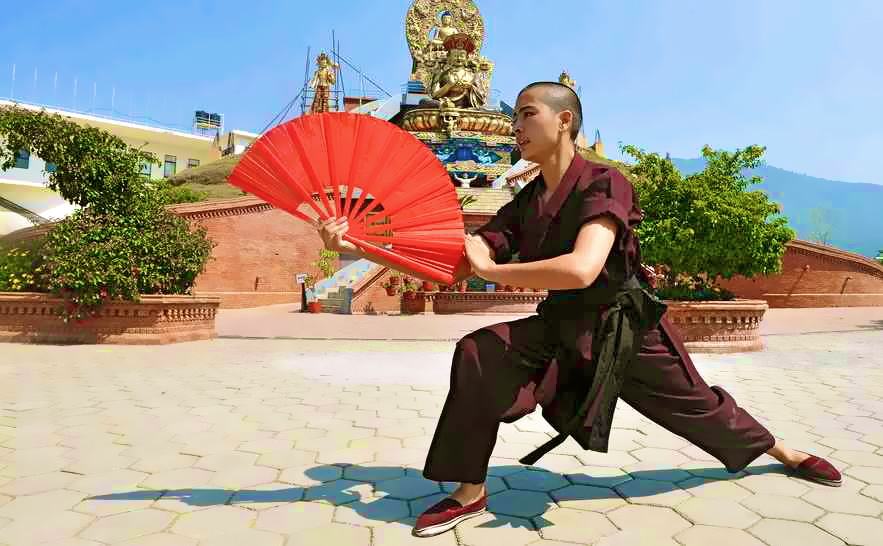 |
The Nuns have said the Kung Fu has both improved their
self-confidence and made them better at Meditation. They have used it
for campaigns promoting community work and against toxic waste, not to
mention women's empowerment. Not only are these nuns helping their
community, but they are also defying gender norms in a larger way,
challenging what it means to be a woman in Nepal.
Nepal is not the worst country when it comes to gender parity, but it's
by no means exemplary. Strides have been made in education, and
enrollment rates for boys and girls in primary and secondary school are
practically the same. But there remains a legacy of inequality, with
only 47% of women literate, compared to 71% of men.
And, as is often the case in poor countries, women and girls suffer in a
multitude of other ways. Women have had to bear the brunt of Earthquake
damages, keeping families together and participating in recovery
efforts, as a substantial number of men are abroad earning remittances.
Public Radio International notes: Women and girls are also particularly
vulnerable to exploitation by human traffickers, who may target Nepal in
the chaos.
This makes populations like the Druk Amitabha Mountain nunnery
particularly important. Their ethos of female empowerment, and their
role in recovery efforts, offers a symbol of hope for women and girls
across the country. |
|
 |
|
 |
|
International Wudang Internal
Martial Arts Academy is run by:
Dr. Lu Mei-Hui and Master Chang Wu Na
Both of whom are Disciples of the Current Headmaster of Wudang Pai
Martial Arts - Sifu Ma Jie |
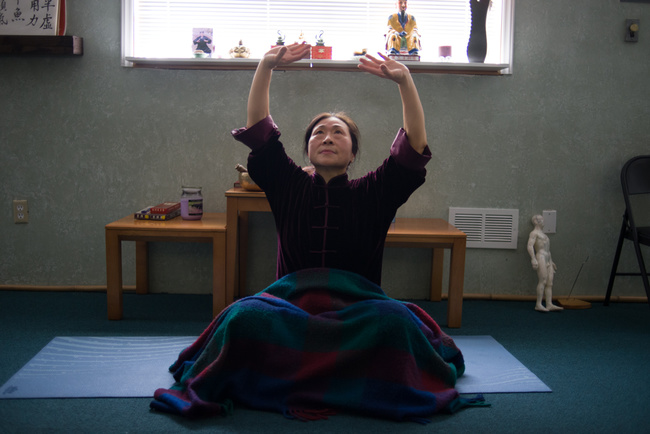 |
The origins of Wudang Dan Pai Martial Arts originate from the
Wudang Mountains of the Hubei Province in China. The
discipline falls under the umbrella term of “Internal Martial Arts”
which is a practice of developing the internal aspects of the human body
in accordance with the external. A more specific focus of this academy
is on the Wudang Chuan, which is a combination of three classic
Chinese boxing styles: T’ai Chi Chuan, Xing-Yi Chuan and Bagua Zhang.
T’ai Chi Chuan, or more popularly known as “Tai Chi”, employs
slow, fluid and graceful movements, and is commonly known as a martial
art that elders practice in a public park. Xing-Yi uses direct
and more aggressive burst movements at short range where intention is
clearly stated, while in Bagua Zhang, practitioners walk
in circular pattern following an eight-trigram octagonal shape, and
strikes and grappling techniques are more concealed. |
| Though Tai-Chi may be the more recognizable by name alone, the other
two styles have made plenty of appearance in the media, such as Bagua
Zhang inspiring the fighting form of Nickelodean’s Airbender, and the
“good” and “evil” characters in the Jet Li film The One adopting both
Bagua Zhang and Xing-Yi, respectively. The presence of these forms in
the movies, however, is what appears to be part of the problem. |
| “The problem is a lot of people nowadays get involved because of how
pretty it looks, so they’re not interested in the fighting technique.
That’s one aspect. And then sometimes you have other people, who
unfortunately because of circumstance, their understanding of the
application is not so great and they go off and become teachers and
become representatives and it kind of spreads a misunderstanding of
Chinese martial arts,” says Master Chang. “Particularly when it comes to
tai-chi. ‘It goes so slowly, it’s so soft. Focus on meditation and focus
on moving chi,’ he continues, imitating modern day masters. “It becomes
a lot of misunderstanding. It shouldn’t be the way it is. Instead,
everything should be very practical.” Dr. Lu echoes
a Similar Sentiment:
“I think the most important thing that I would like you
to understand is that Chinese internal martial art should not just be
for health cultivation. We should go back to the root of what martial
arts is: martial,” says Dr. Lu. |
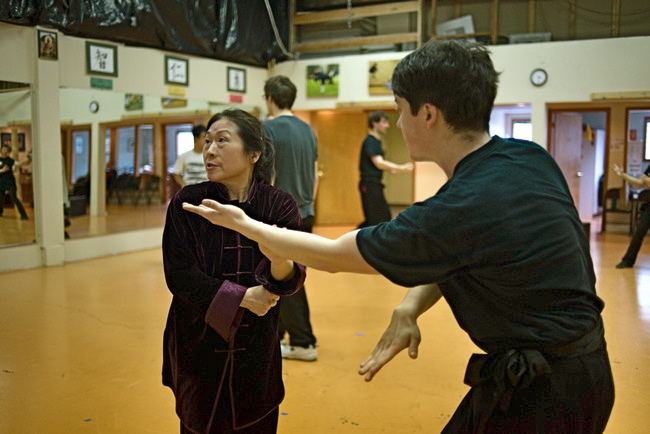
Dr. Lu Mei-Hui
Wudang Chuan Class |
| Dr. Lu continues, “Of course there should be a martial component,
there has to be yang, an application. Without application, all the forms
are empty. It becomes dancing.” Dr. Lu looks and speaks like a kind
grandmother, though there is also an underlying sense of firmness to her
demeanor. Master Chang, on the other hand, is considerably younger and
speaks in a manner more in tune with his generation. Both have a
considerable number of traditional martial arts between them, and based
on their written resumes alone, their abilities could be lethal. And
their traditions that involve backgrounds that sound almost like
folklore. |
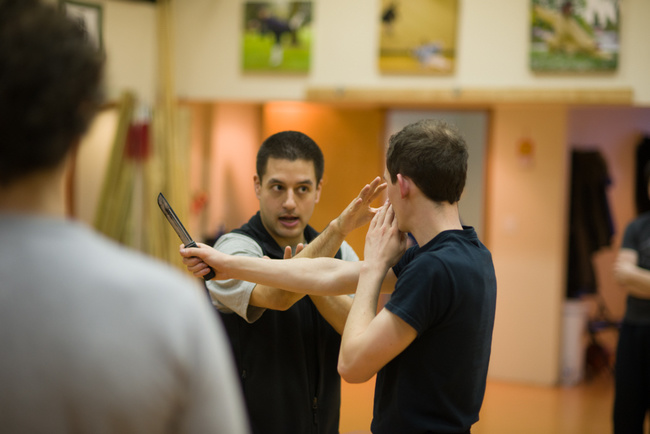
Master Chang Wu Na
Wudang Chuan Class |
About halfway through a Tai-Chi class, the doctor places her hands
above my wrists and instructs me to move them. I make a decent effort to
do so and fail. She tells me to try again. I take in a deep breath,
reassess my approach and push harder. About fifteen-seconds in, I begin
to break a sweat, but her hands don’t budge. Now I’m not saying that I’m
the strongest person in the world, but I am in my 30s with plenty of
Boxing and Jiu-Jitsu experience under my belt and I cannot move this
64-year old woman’s hands.
Afterwards, I stick around for a self-defense seminar led by Master
Chang, and during one of the drills, we’re instructed to place the base
of our palm below the ridge of our opponents’ nose and flip back their
head. The intended effect is to throw the opponent off-balance with a
simple flick of the wrist. I try the movement a few times but the best I
can get is maybe an exaggerated head-nod from my partner. Master Chang
comes by and lightly places his hand under my Philtrum, then flips my
head back with such a sudden and abrupt force that I would have toppled
over had he not caught me with his other hand. |
| I’m told in both instances that I’m focusing too much on the force
and not enough on the technique. I’m sure some of the amazement of those
feats could be attributed to it being a planned drill, but planned or
not, the displayed knowledge of body placement and mechanics is
impressive. Despite my failed attempts, both Dr. Lu and Master Chang
compliment my showing and ask if I’ve had any martial arts training in
the past. I tell them my background is in western boxing and some
Brazilian Jiu-Jitsu, and that most of my contact with martial arts
exists within televised competitive fighting styles, making my exposure
to the traditional martial arts limited. Naturally, a discussion on the
topic ensues. |
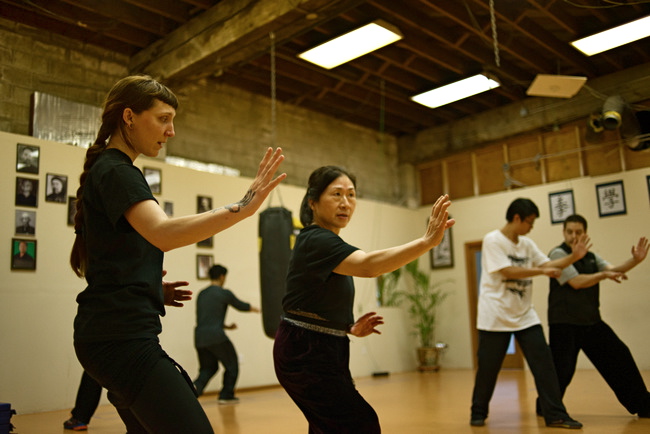 |
“I don’t think there’s been a lot of people who have competed period
in traditional martial arts, at least in Chinese Traditional Martial
Arts,” responds Master Chang when I ask why there isn’t much
representation of traditional martial arts in competitive fighting. “I
think the reasoning behind that is because the people who practice
traditional martial arts are a certain type, of a certain mindset, and a
lot of schools of Chinese Martial Arts, they don’t emphasize that sort
of competition that much, which is not necessarily wrong or right, but
it lends itself to having a bad name sometimes, or at least it opens
Chinese Martial Arts for criticism from the West.
“It’s kind of a complex answer. One part is that in China, MMA is just
starting to gain some traction and popularity and in the past there
hasn’t been that much enthusiasm, that’s number one. Number two is that
the methodology, not everyone agrees with. For example, Brazilian
Jiu-Jitsu, rolling on the ground, that’s kind of been met with some
derision amongst the Chinese. It’s starting to change now, but in the
past that’s been the case.” |
| I bring up the argument of how the lack of presence on a competitive
stage like cage fighting suggests a notion that traditional marital arts
are ineffective. After all, the original intention of the UFC was to
prove which fighting style reigned supreme. Master Chang had different
thoughts on the matter. “Well there are a lot of martial arts that are
very useful that are not proven in the cage. I don’t see a lot of people
that do Pencak Silat or Krav Maga in the cage,” Master Chang starts. |
| “The people who enter the cage are those that do western boxing,
Brazilian Jiu-Jitsu and a little bit of Muay-Thai, and they go in, with
an emphasis on the Brazilian Jiu-Jitsu, the ground fighting. You have to
have that. You can be garbage with the hands and you can be garbage with
the legs, but if you can put the guy on the ground, then you can finish
him that way. That works extremely well in the competitive environment.
In other situations, it’s not necessarily called for. In a combat zone
where you have people with machine guns, for example, things like Krav
Maga, or Pencak Silat, work very very well. The Marines they have their
style of marital arts called LINE. None of those things have been proven
in the cage either, but they’re employed by governments to be used in
combat zones, so just because it’s not proven in the cage does not mean
it’s not an effective martial art.” Valid Point -
Intention |
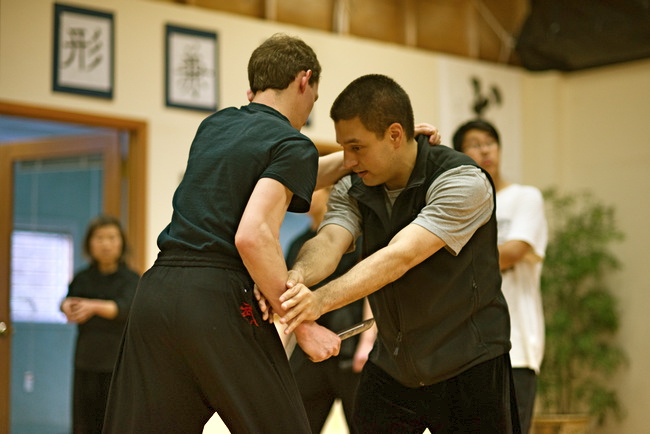 |
| Intention should always be taken into account when discussing the
legitimacy of a fighting practice, and a controlled environment is
entirely different from one that is life-and-death. “Personally, I
have respect for all styles of martial arts because they must have their
reasons why they’re set up that way,” says Dr. Lu when I ask her
opinions on other competitive fighting styles. “For example, Boxing is
very good. I also trained for a while in Kickboxing and I like it. I use
it as a Yang, to apply. When I need to fight, I use the technique. But I
would not use that to nurture my health.”
Her claims of training in experienced competitive fighting arenas are
not unfounded. She once taught English to Anatoli Rubin, the former head
coach for the Olympic Boxing Team of the Soviet Union, and received
Boxing instruction during the language exchange. She also spent some
time training with professional Kickboxer Iro Evanson, and holds a vast
library of knowledge to a variety of fighting styles. In regards to her
comment about health, it is worth mentioning that she is also a
certified practitioner of Chinese Medicine and Acupuncture, two elements
that are incorporated into her approach to fighting.
“A lot of people claim that they have trained for a certain number of
years in this and that, and when they come to us it turns out they were
patients. They were very sick,” says Dr. Lu when I ask how a focus on
how health cultivation affects a fighter. “They are good fighters, no
doubt. I’ll never deny that, but when it comes to internal strength,
they have to work on this.” |
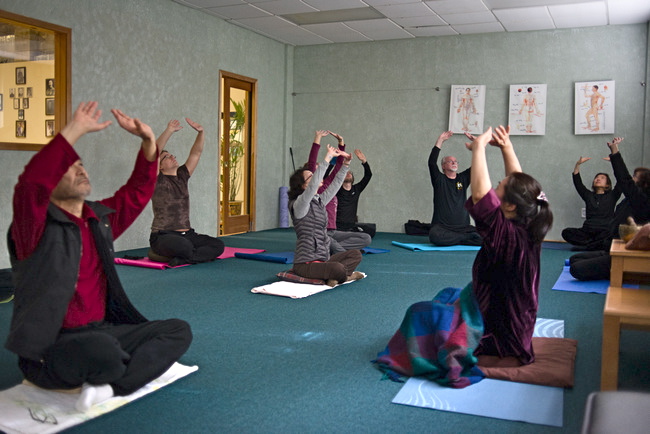 |
The focus of the Wudang is set upon both the fighting ability and
physical well being of their students. However, they also contest that
integrating the softer, healing elements of martial arts will actually
enhance the harder and more aggressive aspects of competitive fighting.
At least for Wudang, the debate between traditional martial arts and
competitive martial arts is kind of a moot point. They are essentially
two sides of the same coin.
“Yin Yang Theory is a crucial part of the core in the Chinese
Philosophical System. It states how ancient Chinese categorized the
energies in everything. Yin and Yang are two contrasted concepts. Based
on the theory, these two energies embrace each other, support each other
and also confront each other. They coexist and there should be balance
between them.
Overpowering of one of them will harm the other,” says Dr. Lu. |
| “If there’s only Yin, there’s no Yang. If there’s no Yang, there’s
no Yin. There has to be two. Without knowing how to be soft, it’s very
difficult for you to issue the hard energy. So that’s why both hard
energy and soft energy have to be cultivated and applied in combative
situations.” |
|
Brutal Festival Takes Over the
Bolivian Andes |
|
Each Year in early May the Hills and
Towns of Bolivia Erupt with Violent Fighting
Weapons are Fists and Stones - People Die
And after a few days Everything goes back to Normal
This is Tinku |
There may be no tourist attraction in the world quite like Tinku,
the ritual street battles practiced by some indigenous communities in
the Bolivian Andes. Visitors return with reports of chaos and brutal
warfare, fueled by homemade booze, in remote mountain villages.
Tinku, which means something like “Violent Encounter” in Aymara, is the
most notorious element of certain festivals celebrated by two native
groups in the Andes, specifically the Aymara and the Quechua. In
addition to the brawling, the festivals also include feasts, elaborate
dances and huge, choreographed musical events. Some of the biggest are
held in the towns of Macha and Potosi. |
|
Traditional Tinku Costumes |
Tinku is a heavily ritualized form of battle, but the skirmishes
aren’t supposed to be personal. Traditionally, the fighting may have
been meant to honor Pachamama, a Bolivian goddess, but these days it’s
more like a sport than anything else, a way to prove one’s bravery.
Village against village, villager against villager. Where once there was
peace, suddenly there is war, and just as suddenly, that war will end.
The teams, such as they are, tend to be made up of Ayllus, originally
extended family units that have over the years become small, tight-knit
communities. The fights are pre-arranged; you don’t just go in swinging,
like a mosh pit. Tinku is a heavily ritualized form of battle, but the
skirmishes aren’t supposed to be personal. Traditionally, the fighting
may have been meant to honor Pachamama, a Bolivian goddess, but these
days it’s more like a sport than anything else, a way to prove one’s
bravery. Village against village, villager against villager. Where once
there was peace, suddenly there is war, and just as suddenly, that war
will end.
The teams, such as they are, tend to be made up of Ayllus, originally
extended family units that have over the years become small, tight-knit
communities. The fights are pre-arranged; you don’t just go in swinging,
like a mosh pit. There are generally only one or two of these festivals
per group each year. |
|
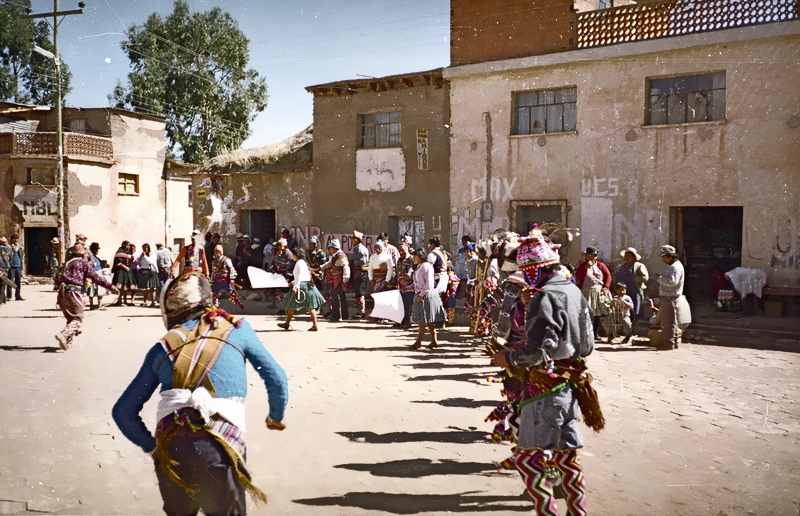 |
|
Tinku Festival in Macha, Bolivia |
The attire and methods of fighting are formalized as well. Many wear
colorful costumes, and sometimes a traditional sort of helmet. Fighting
is at first done only with fists, and later supplemented with weapons
like rocks.
Theoretically, there are rules to prevent people from getting injured
too badly. Police and community authorities are usually at hand to stop
the fighting if one person has fallen to the ground., though once the
stone-throwing starts, all bets are off. Deaths during Tinku are not
unusual. |
|
Tinku Festival in Macha, Bolivia |
Sometimes underlying conflicts between groups can also surface and
the fighting can get ugly and carry on after an opponent has fallen to
the ground.
Usual depictions of Tinku are wrapped up in themes of drunkenness and
poverty, and indeed beverages like Chicha, a sort of cousin of beer, are
certainly a major part of the festivals. Tinku is not indicative of the
rest of the year. The people work incredibly hard and relatively few
days each year are dedicated to festive activities with drinking and
music.
The government of Bolivia has a nuanced and complex view of things. They
try, with varying degrees of success, to limit the mayhem, but also
recognize that Tinku is a legitimate tourist attraction. For the people
who participate, though, it’s a necessary explosion of energy, a way to
vent and avoid existing in a state of anger for the entire year. They
might be onto something. |
|
Warming-up for a Tinku Rivalry in Macha, Bolivia |
Blood on the Ground after a Tinku Brawl |
|
The Martial Arts Master Who Has
Lived in Three Centuries |
|
"The Yangtze Great Chivalrous Man"
|
|
He is a legendary man
whose life has crossed three centuries. Born in 1893, the 19th year of
Emperor Guangxu's Reign (Ching Dynasty), he was 118 years old on October
21st, 2012 when he died surrounded by his family and closest friends,
just one month before his 119th anniversary. |
|
When asked what his secret to longevity is, Mr. Lu
said, "The key to a long and healthy life is a combination of movement
and stillness—cultivating life by guiding the Chi, the vital energy in
the body, and moving the hands and feet through practicing Chinese
Boxing." |
| He lived in Chongqing City, Sichuan Province, China. Despite his
age, he was healthy and lithe. Once considered one of the top three
Gong-fu masters, Lu was adept at martial arts and could still move a
young man of around 150 pounds 15 feet away with just one push. |
| According to Xinmin Evening News, Lu Zijian started learning martial
arts with his mother at the age of seven, and in 1920 the 27-year-old Lu
won the martial arts contest held at Yuhuatai, Nanjing City. He became
famous in Shanghai in the 1930s and was granted Level Nine status—the
top rank in Chinese martial arts. |
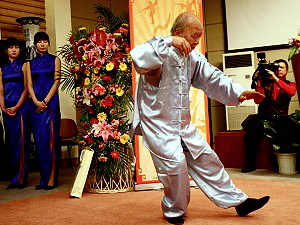 |
Lu fought foreigners on two occasions, and before
each of the competitions he signed a waiver that said no one was
responsible should a death occur during the fight.
The first foreigner was an American named Tom, who was over six feet
tall. The two men battled for more than an hour and still there was no
clear winner. Lu's hands were badly scratched when one of his disciples
called out, "Master, use Eight Trigram Palm!" Lu recalled, "I was in a
hell of a fight and had become confused." When his mind became clearer
he began to walk around Tom, using Eight Trigram, and finally hit Tom's
chest with his palm. Tom stumbled backward a few steps then fell to the
ground, blood gushing from his mouth.
The second fight was with a Japanese Tae Kwon Do master in Shanghai.
He was simply no match for Lu and ended up in worse shape than Tom. |
|
Lu Zijian - 2009 |
When he walks or climbs a mountain, he feels light as
a feather. |
Since he turned 86 years old Lu has attended every martial arts
contest he could. When he was 93, he joined the Martial Arts Training
Team of Sichuan Province and took part in the National Martial Arts
Competition held in Sichuan.
A close-up look at Mr. Lu reveals that his face is almost free of
wrinkles and his skin has an iridescence to it. His shoulders are broad
and his arms are muscular. His gray hair is dotted with newly grown
black hair. At age 95, his skin began to peel. Years later, the skin on
his face, hands, and body was gone, and a new skin appeared. According
to Mr. Lu, now his skin changes every three years.
He is a vegetarian, staying away from meat and fish. He meditates for an
hour and a half starting at 2 p.m. and goes to bed at 11 p.m. |
|
Martial Training Exercises from
Around the World |
|
Paramilitary Chinese Police Officers during a
Psychological Training Program |
|
Chinese Swat Officer at Antiterrorism Drill |
|
Frontier Soldier from the People's Liberation Army |
|
German Special Forces - Mount Gun Underwater
(Holding their Breath) |
|
Elite Forces in Nicaragua - Train for Jungle
Fighting |
|
South Korean Special Forces - Antiterror Exercise
in Seoul |
|
South Korean Special Warfare Forces - Winter
Mountain Training Exercises |
|
Mexican Marine - Training at a Military Base |
|
Belarusian Special Forces |
|
Shi'ite Fighters - The Desert in Najaf, South of
Baghdad
This Military Exercise is Brutal, Stand Up or Get Beaten |
|
Shi'ite Fighters - Knife Fighting in Najaf, Iraq |
|
Israeli Soldiers - From the Alpine Unit |
|
Iran Basij Militia - At a Mosque in Central Tehran |
|
Philippine Recruits
If the Banana Falls, they Eat it Peel Included |
|
US Marine Drinking the Blood of a Cobra - During a
Jungle Survival Exercise |
|
Taiwanese Marine Frogmen
Crawl Through Rocky Pathway - the "Road to Heaven" |
|
Colombian Policemen - Train in Camouflage in the
Jungle |
|
Angampora combines the use of
Indigenous Weapons, Hand-to-hand Combat and Meditation |
|
Angampora is an Old Martial Art Form -
created 'According to Legends' more than 30,000 years ago, in
Sri Lanka
The practice nearly disappeared when Britain took over the
Sri Lanka in 1815 and banned Angampora
A few families passed it through generations, and so the Art
survived, until the country gained independence, over 100 years
later |
|
A Traditional Angampora Seated
Meditation Pose |
Meditation Pose Using Balance
An Essential Element in Angampora |
|
Demonstrating the Fighting Style -
Illangam (Fighting with Weapons)
Traditional Angampora Weapons |
Illangam - Fighting Style using
Traditional Angampora Weapons |
|
Illangam (Fighting with Weapons) |
A Fighter uses Gataputtu - a Series
of Locks and Grips
Exact Maximum Pain on the Enemy |
|
Fighting Style of Angam - Form of
Hand-to-hand Combat |
Fighters were Trained to Jump
Extraordinarily High to Attack and Defend Against Enemies on Horseback
or on Elephants |
|
Illangam (Fighting with Weapons) |
Traditional Angampora Meditation
Pose |
|
Angampora Fighters Demonstrating
- Kadu Pali Satan |
Kadu Pali Satan - Traditional
Fighting Style with Swords and Shields |
|
Fighters Conducting a Pre-fighting
Pooja (Act of Worship) |
Ath Haramba - Choreographed Pattern
of Movements
Practiced either Solo or Pared |
|
Papa Machete is an intimate account of 'Professor'
Alfred Avril, one of the world's only known masters of the esoteric
martial art of Haitian machete fencing, known in Creole as
'Tire Machet'. The film documents a proud, but aging man's
devotion to his heritage and his desire to continue tradition. |
Alfred Avril, right, instructs a student in the little-known
martial art of
Machete
Fencing near the town of Jacmel, Haiti. An effort
to bring awareness about the obscure tradition has been launched by a
small group of aficionados that have formed a group called the Haitian
Machete Fencing Project.
JACMEL, Haiti - Two men pivot and slide in a forest clearing,
their bodies weaving before a handful of spectators in what could be a
graceful dance except that each waves a machete, blades glinting in
tropical sunlight.
The barefoot men are father and son, Alfred and Roland Avril, and are
farmers by trade in southern Haiti. Their passion, however, is machete
fencing, an obscure martial art with roots in the Caribbean country’s
history of slavery and rebellion. In the smoky, greenish light under the
trees of his property, 70-year-old Alfred, a master of machete fencing,
moves back and forth in fluid, trance-like steps. |
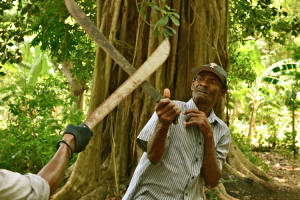 |
| Avril explains later that his skills have been honed through decades
of practice and mystical visions. “At the moment I am about to fight
with the machete, I can see it all unfold in a dream,” he said without
further explanation on a recent morning. This obscure practice that
emerged around the Caribbean in the colonial period is gaining new
attention thanks to the very modern phenomenon known as Reddit. Videos
showing the elder Avril instructing students were posted on the popular
Internet site, catching the attention of a Miami-based writer and
filmmaker who quickly was hooked with the menacing beauty of the
fencing. “When I found out that there was an actual martial art using
the machete, and that somehow it was wrapped up in the history of the
Haitian revolution, I knew I had to go to Haiti to train,” said Jason
Jeffers, one of the founders of the Haitian Machete Fencing Project,
which seeks to promote and preserve a vanishing practice.
Jeffers is putting the finishing touches on a short, crowd-sourced
documentary about Avril called
“Papa Machete”
(Trailer) that he’s hoping to get into film festivals.
He’s in early planning stages for a full film, perhaps featuring other
machete masters in Haiti’s central Artibonite region, where the
tradition is most common. Other project members are organizing summer
training sessions with Avril in the southern beach village of Jacmel. |
|
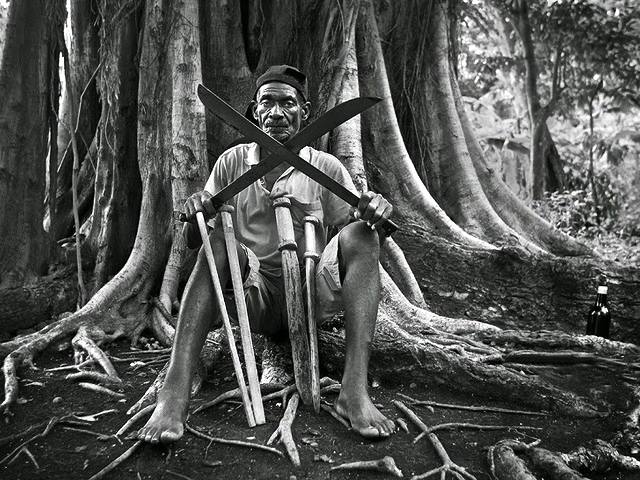 |
Experts say machete-based martial arts can be found among people of
African descent in other countries, including Colombia and Cuba. Related
styles of fighting include “Stick-licking” in Barbados and “Kalenda” in
Trinidad and Tobago. But the Haitian tradition is a unique fusion of
traditional African stick-fighting and European saber fencing that
researchers say can be traced back to the earliest days of Haiti’s slave
revolution at the end of the 1700s.
T.J. Desch-Obi, an associate professor of history at New York’s Baruch
College who has researched machete fencing, said the art is rooted in
combat methods used by the slaves who rose up against their French
oppressors in the Haitian revolution of 1791-1804.
“Haiti’s revolution really started with just machetes in the early days
of the war when they didn’t have much access to firearms,” said
Desch-Obi, author of a 2008 book “Fighting for Honor: The History of
African Martial Art Traditions in the Atlantic World,” which suggests
expertise in machete combat contributed to the success of the slave
revolution. |
|
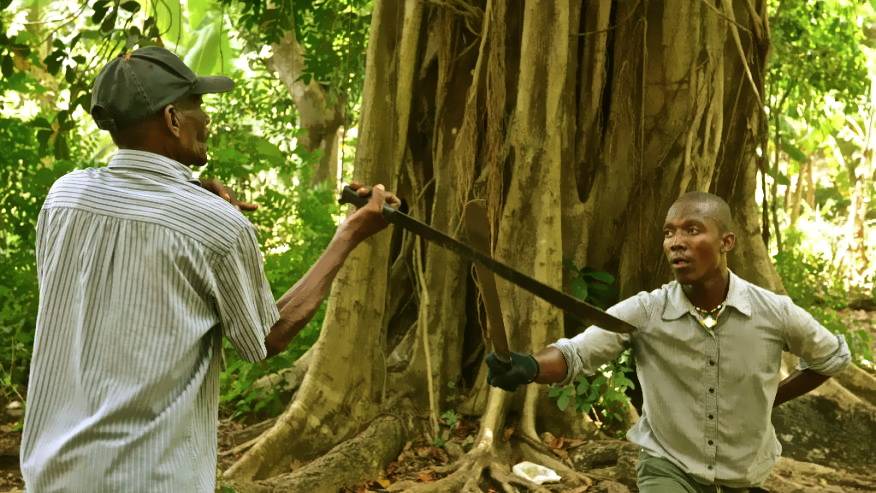 |
In the 20th century, Haiti’s machete-fighting tradition was kept
alive by secret societies that required initiates to learn the art,
Desch-Obi said. Over the years, he said, he has met about 10 machete
masters in Haiti but the exact number in the country is unknown.
It’s imbued, at least in Avril’s version, with some of the esoteric
ideas of Voodoo, a blend of West African religions created by slaves
during the colonial period also known as Vodou. The martial art served
mostly as a means of self-defense among people living in the Haitian
countryside where the handy agricultural tool is used for nearly every
purpose under the sun.
Michael Rogers, founder of the Haitian Machete Fencing Project, hopes
that showcasing the tradition for visitors will help his aging teacher
and preserve what remains of the practice passed down through
generations. Although Avril lives close to Jacmel, a coastal town that
draws tourists, it tends to be practiced by people in communities deep
in the countryside where few foreigners venture.Historically, the
rural tradition of machete fencing has been shrouded in secrecy.
Initially, Rogers said Avril would only instruct him behind a wall of
woven coconut fronds.
Trying to bring the secretive, rural Haitian martial art to foreigners
involves certain trade-offs, but Avril is now eager to share his
machete-fighting expertise with anyone who is interested. The former
Haitian army drill instructor trained his sons, grandsons and neighbors
to carry on his school.
So far, Avril says he’s instructed about a dozen people from abroad.
Novices are instructed on faux-machetes carved out of wood. Students say
it takes weeks to graduate to a real machete.
One of Avril’s veteran students is local bar owner Reginald Turnier, who
was raised in the New York City suburbs by Haitian parents. He feels
like he’s unlocking the fighting techniques of his ancestors, and has
several small scars on his hands and scalp from early lessons. “There’s
definitely a martial lineage I feel I’m connecting to,” he said. |
|
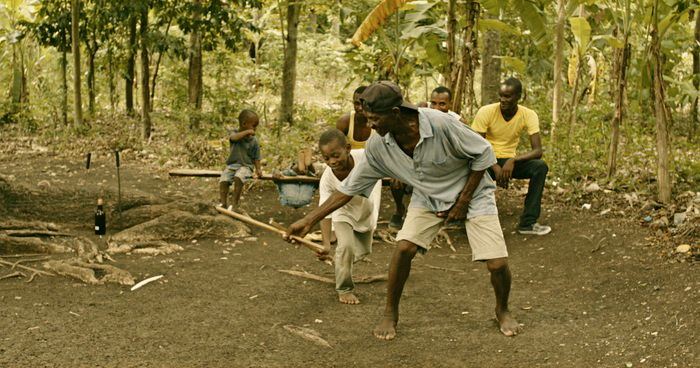 |
|
Clog Fighting: the Victorian
Martial Art |
|
The Violent and Bloody "Sport" of
Clogfighting - Remembered in England |
|
Not for the
Faint-hearted
Clog fighting, a mill town pastime
dubbed a 'martial art of the Victorian era, was used as
a way of settling disputes. Men would square up
face-to-face to kick the unprotected shins of their
opponents with their wooden, metal-soled clogs. In
illegal duels which would make American football look
serene either whoever submitted first, or whoever drew
blood first, lost.
It was officially known across Greater Manchester and
Lancashire as 'purring' and common in towns including
Rochdale and Wigan. The history of clog fighting is in
all its gory detail.
The working class contests were often
played out with 'a bawdy good humor and strong vein of
chivalry'. |
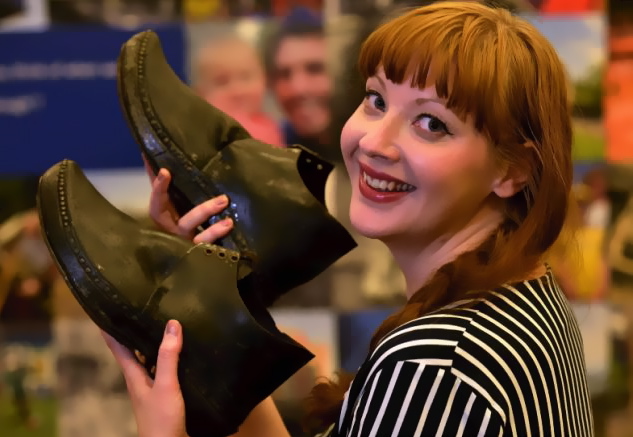 |
|
Ink sketches depicting contests are
drawn from eye-witness accounts and records. |
Clogging fights are believed to have started in the
1700s within mining communities and continued until
around 1910.
It was classed as a sport because although illegal,
there were rules and fights would be held at specific
locations. Gambling also played a part.
Fights were used to settle disagreements but there were
also professionals who would tour as far as the borders
of Yorkshire. People who were champions earned good
second wages. Archive records reveal reports of naked
bouts and serious injuries.
There were different variations and often referees.
There were probably more misses than hits but often
people were badly hurt. Children would often be paid to
act as look-outs at contests. |
|
|
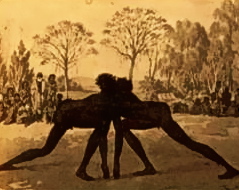 |
 |
|
Inspired by Boxing Kangaroos, an Ancient form of
Tribal Warfare is being re-taught in Remote Indigenous Communities |
Meaning “Kangaroo Spirit” in the language of the Ngiyampaa
people of western New South Wales, Coreeda takes its style from boxing
Kangaroos.
Cast adrift into the Gulf of Carpentaria, the Mornington island is about
as isolated an area as you’ll find anywhere in Australia. For young
people growing up in remote communities can be a challenge. With the
kids from Mornington Island increasingly listless and bored, even
resorting to violence, the community has acted.
"We were invited to Mornington Island to try and utilize the sport to
help the kids in town manage aggression and inspire them towards
traditional culture," Coreeda Association Australia. Not only is this an
opportunity to channel aggression and let off steam in a controlled
environment, but it’s also a way to rekindle an age-old tradition. |
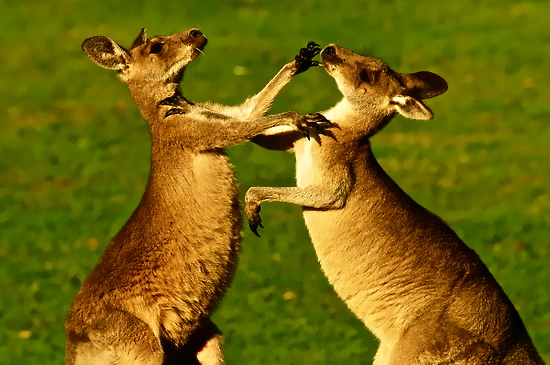 |
|
A Form of Wrestling - Two Fighters use Only Their
Arms to Grapple with their Opponents |
| Different rules exist in different areas, Tur-der-er-rin from the
Kulin people of Southern Victoria; Partembelin from the Nyeri Nyeri
people of Northern Victoria; Ami from the Jinibara people of South
Eastern QLD and Arungga from the Kokomini people of Cape York. |
|
Origins
The dreaming story of Coreeda is about a lizard man named Beereun,
who was told by a giant snake to watch the Kangaroo buck so he could
learn how to fight without weapons.
He then brought these techniques back to his clan and started a
wrestling tournament as an important peace-keeping ceremony.
The story was told originally in Cobar and the story was kept alive by
one of the Elders in town back in the 1990s. He verified the creation of
Australian Wrestling by showing the artwork out there in Mt Grenfell. |
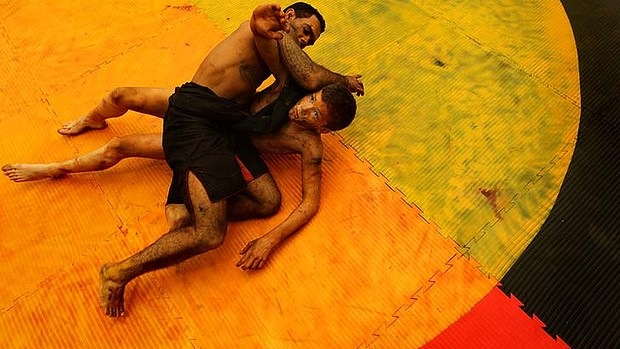 |
At the Mt Grenfell historic site, about 40km west of Cobar, ochre
depictions of Coreeda tournaments were painted on rock walls, dating
back as far as 30,000 years.
"All the kids were fantastic, getting in there and having fun, but there
were a few kids there who were just naturally talented and looked like
they’d been training for years,” Coreeda instructor. |
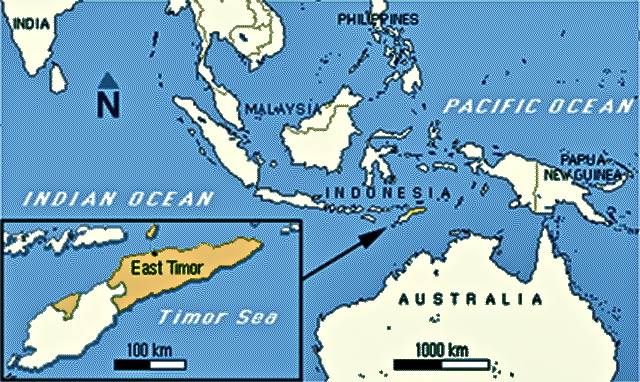 |
 |
|
Prime Minister Xanana Gusmao of
Timor Leste (East Timor) issued a proclamation banning the practice of
Pencak Silat, an indigenous martial art that is wildly popular
throughout the region. The actual news story and press release
leave many unanswered questions. Which of Timor’s notorious
martial arts gangs in particular are actually being banned? Who
gets to define “Silat” in what can only be described as a very
complicated martial arts community? Other disciplines, such as
Akido, Kung Fu, Judo and Tae Kwon Do appear to be unaffected by the new
law. But a pretty wide range of South East Asian arts will likely
be affected by this legislation. |
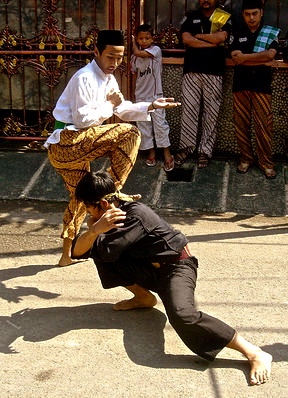 |
East Timor police say there will be zero tolerance against those who
continue to practice a local martial art after the government banned all
clubs following deadly gang violence, an official said Monday.
At least 12 East Timorese have been killed and more than 200 injured in
the past two years as a result of fighting among rival pencak silat
clubs, said Armando Monteiro, National Police detective chief. Two were
killed in neighboring Indonesia, while other deaths and injuries have
occurred as far away as England and Ireland. He said the number of
casualties is likely higher since many people are afraid to report gang
activity or go to the hospital for treatment.
"Any martial arts clubs members that violate the government resolution
will be dealt with under the law," Monteiro said. There will be "zero
tolerance for martial arts activities in the country."
Schools and clubs for pencak silat, an adapted form of the Indonesian
martial art, have a long history in East Timor, with many students in
the past fighting against Indonesia's military occupation. They also
became active clandestine members in supporting guerrilla fighters and
some made significant contributions toward winning the country's
independence in 2002.
Later, martial arts students became rivals and began killing each other
in the streets as happened in 2006 during a violent political crisis
that left dozens dead and tens of thousands displaced in the tiny
half-island nation. |
In many villages across East Timor, students start learning pencak
silat at age 13. Less popular martial arts, such as karate, kung fu,
taekwondo and judo, are not banned.
Prime Minister Xanana Gusmao issued a resolution outlawing the popular
clubs two months ago. He said he has tried to work with the groups for
years to allow them to continue to operate peacefully, but said the
original purpose and philosophy of martial arts has been lost in East
Timor.
"I have no more mercy and no more patience," said Gusmao, who added he
has tried to work with the groups since becoming the country's first
president in 2002. "I cannot tolerate the situation anymore, and I
cannot permit it anymore." |
Gusmao said police and members of the military have been told to
leave martial arts groups or be fired.
Some clubs have publicly handed over their uniforms to police in front
of government officials, but police say some members continue to conduct
their training secretly at night.
Monteiro said anyone caught violating the resolution will be punished
under the law. Seven martial arts clubs were registered, but many others
exist without the government's knowledge making it difficult to estimate
the number of members nationwide.
Last month, one East Timorese student was killed at Widyagama University
in Malang, Indonesia, and another had his hand cut off with a samurai
sword by a martial arts gang member. |
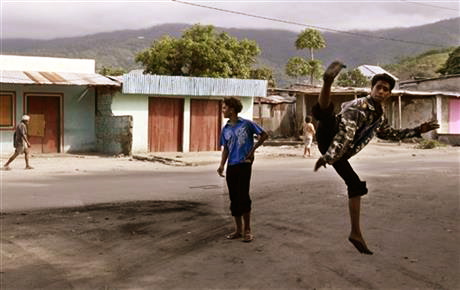 |
| "I need justice because the suspects who cut off my hand have not
yet been captured by the police," said Jacinto Cipriano Ximenes, 25, a
final-year telecommunications student who plans to return to school and
finish his studies this year. |
|
Burmese Martial Art Attracts
Fighters From Across Asia |
Burma's most popular martial art, Letwhay, just like the
country itself, is attracting attention from people from far and beyond
for the raw nature as well as the skills. This is not a for the faint
hearted. Letwhay is the Burmese version of Muay Thai Boxing
and it is growing in popularity across Asia.
"You don't use gloves, so it is very frightening. Muay Thai started out
during wartime in Burma, and at that time, people fought with bare
fists. The modern form of Letwhay only became popular after the
second world war, where bouts were contested with bare hands and fights
went on until one of the competitors was knocked out completely.
If more fighters decide to travel to Burma to fight in these events, it
could signal a bright future for both Letwhay and Burma. |
|
Burma’s Hidden Martial Art |
|
On the eastern side of Inya Lake in Yangon, tucked
away in a narrow alley, is a Letwhay gym.
Even when you walk right in front of it, the exact spot is hard to find
without asking a resident.
This almost hidden facility teaches under a corrugated
roof with few training tools available. |
| Letwhay is the country’s Traditional Martial Art, a
discipline that is practiced without gloves. There are only cotton
bandages to protect one’s hands. It allows for a number of different
moves. Opponents can be Punched, Kicked, Grabbed by the Neck and even
Head-butted. |
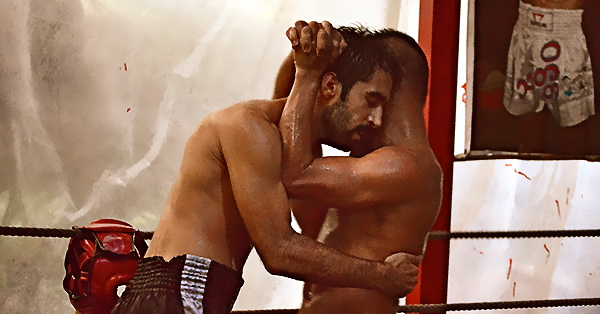 |
Matches are relatively short – only five rounds of 30, painful
seconds each – and Victory is achieved by
Knock-out. If one of the two contenders cannot defeat his
adversary before the time is up, the match is declared a draw.
The rules of the game might seem tough, but they are actually less
arduous than they used to be 20 years ago, when draws were not
contemplated and fights would go on until one fighter threw in the
towel.Letwhay is similar to Muay Thai but there are differences. In
technical terms, Letwhay uses more parts of the body. One significant
thing is the Head Butt and the Throwing (grabbing and crashing an
adversary on the ground). |
| The discipline does not lack a long historical pedigree: it has been
a fighting system and an occasion for entertainment for a long time,
with fights often staged during local festivals.
People in Myanmar [Burma] keep on thinking that all champions
must necessarily come from Burma. |
Only a very small part of the students continue on through to the
professional level, as fighting on a ring is challenging, both because
of the intense training required and because matches are nasty affairs
involving bleeding noses and aching joints.
Lone Chaw is one of those who made it. Tall, still muscular in spite of
having retired a few years ago, he went beyond what most other fighters
manage to do, becoming a champion recognized all over the country. He
first took interest in Letwhay after witnessing a fight in a village.
From then on he trained without pause. |

In Klong Prem high-security prison in Bangkok, inmates box
outsiders for money, shorter sentences, and the greater glory of
Thailand.
Video |
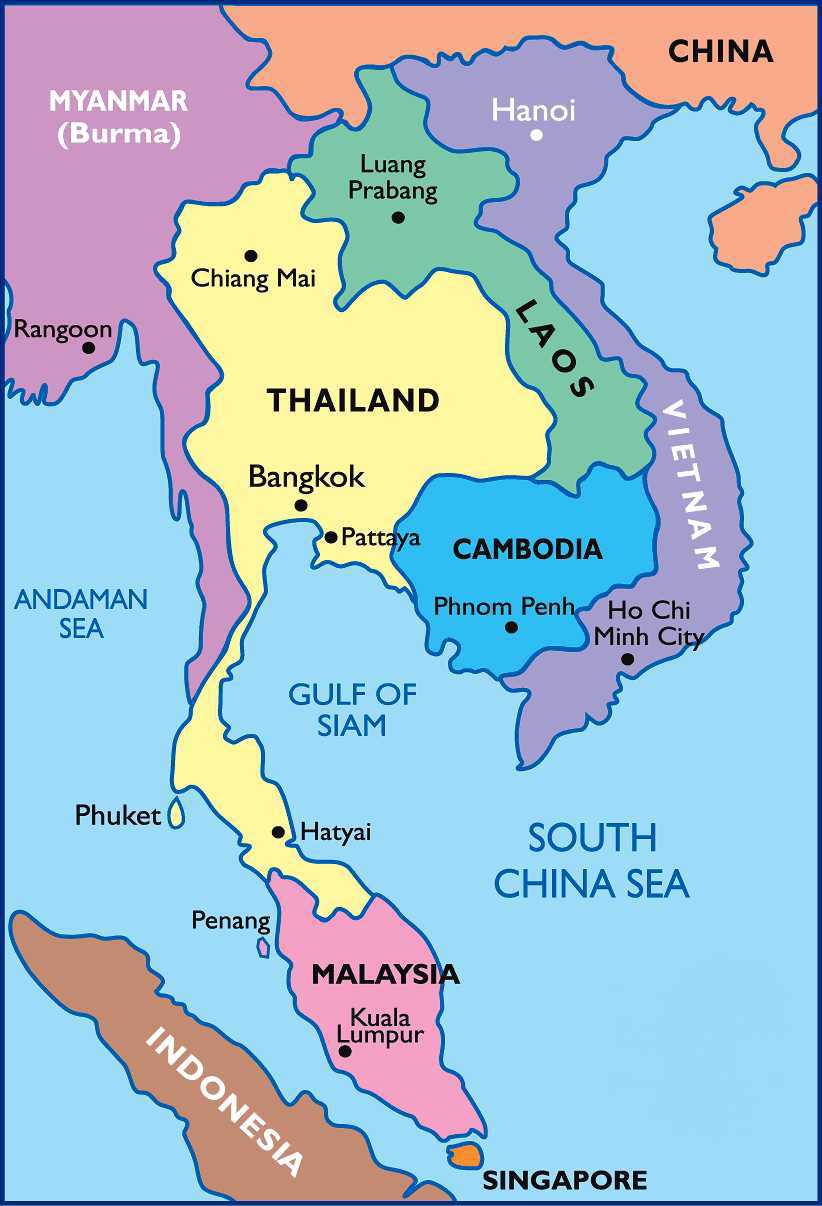 |
|
|
An Attempt to Revive the Ancient
Kalaripayattu Martial Art in Kerala, India |
|
The National Kalaripayattu Championship was held in
Trivandrum in Kerala, India. The championship which aims to keep alive
India's most ancient martial art form had participants from all over the
country. The number of people participating in the contest has
reportedly trebled this year.
Video |
|
Gravity Defying Martial Art Form
|
|
One of India’s Most Famous Martial
Arts
Kalaripayattu is now practiced mostly in Kerala, India
It Literally Translates into "Fighting and Training Place" |
|
It is said to have been Created by Parashuram an
Incarnation of Lord Vishnu
When Lord Shiva came and Taught Him the Art
Over the Centuries the Combatants Refined their Technique |
In the centuries preceding India's independence this Art was
suppressed, people practiced it in secret, hence this is one of the few
Indian Martial Arts that are flourishing in today’s times. Just like
Kung-Fu that has many movements mimicking animals, so Kalaripayattu too
has movements that mimic animals.
There are different kinds of Kalari or practice grounds. When learning
the ropes, this Martial Art gives you an overall development of Mind,
Body and Soul. Warm up exercises make the body ready for actual
training. There are various body positions for attack and defense, as
well as various other movements. |
|
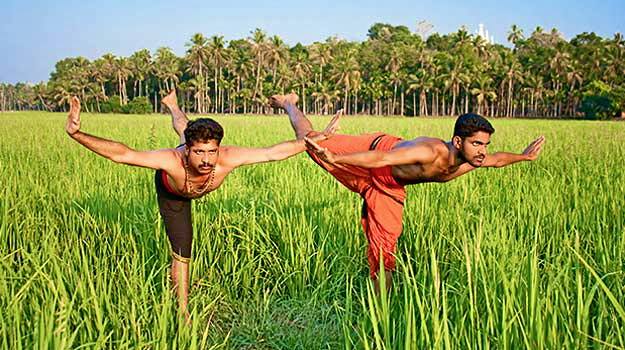 |
|
When one becomes a practitioner, they gradually evolve
in this practice. The journey is an extremely difficult one; one that
pushes you to make your body extremely supple and ultimately discipline
one’s entire being and soul. One learns to become calm and patient. The
practitioners’ reflexes become sharp; all the senses get heightened and
developed with time. Each movement is performed with acute precision.
The students and mentors alike develop a deep connection with the
divine. |
| The weapons’ training is also fascinating. Students train with
various wooden sticks. There are weapons such as swords, shields, spears
and daggers. There are different ways to use the weapons against an
opponent. Each combat stance is enthralling to watch; as is the bare
hand combat. In combat, one can observe just how agile and flexible the
warriors are; yet their movements are graceful and harmoniously
balanced. If you happen to visit Kerala, watch this entrancing martial
art form in person. |
|
Shaolin meets Kalaripayattu in
Beijing |
|
The Occasion was a 'Kerala Evening'
- Organized at the Indian Embassy in Beijing
Six Performers of Kalaripayattu, joined hands with, Shaolin
Exponents
Rare Fusion of the Two Traditional Art Forms in the Chinese Capital |
A shared cultural heritage. Like Kerala, China has a rich tradition
of classical art forms such as the famous Dragon Dance. China and Kerala
shared several cultural traditions like Martial Arts, Ancient Medicinal
Systems (Kerala's renowned ancient medicinal system of Ayurveda) and
even kitchen utensils.
Relations between the people of China and Kerala go back centuries when
traders from China and Kerala traded commodities like spices and silk
along the ancient trade routes; the Spice Route and the Silk Route,
linking both with the rest of the World. Kerala is a tiny state of
India, but it is blessed with a rich geographical and cultural
diversity. |
|
Shaolin Exponents Effortlessly Mingled with
Kalaripayattu Performers in a Scintillating Display of Martial Arts |
|
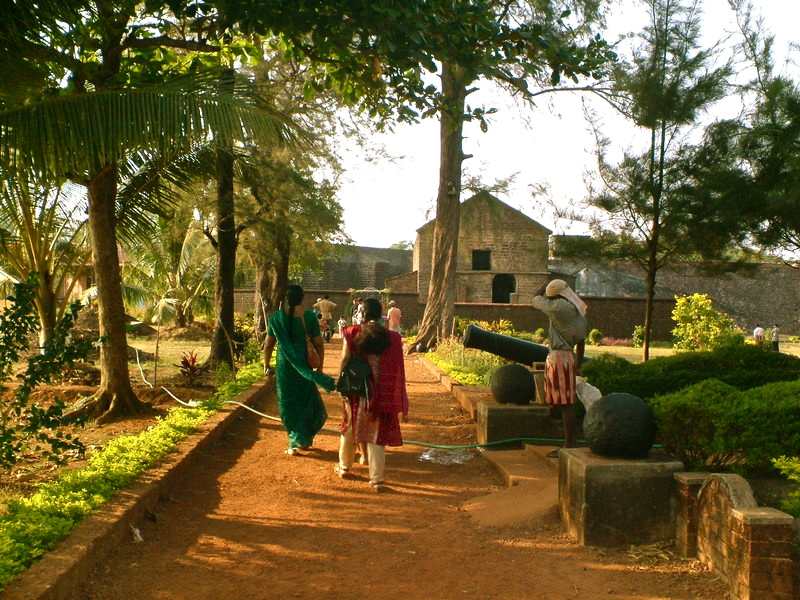
Kannur Angelo Fort - Kerala, India |
|
The martial art of Gatka is a style
of fighting with sticks between two or more Gatka players.
Sticks are intended to simulate the sword with a focus of infusing
physical, spiritual and mental fitness |
|
The International Sikh Martial Art Academy
organized their first Hola Mohalla Virsa Sambhal Gatka Tournament |
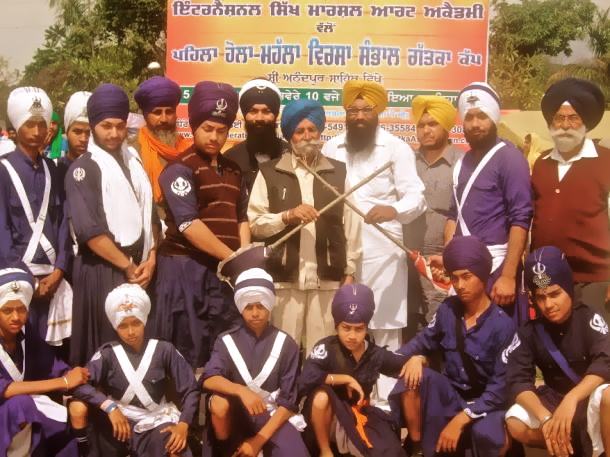 |
Under the aegis of Gatka Federation of India, in
which eight Gatka teams demonstrated their fighting skills
After inaugurating the traditional martial art competition, Dr Deep
Singh Joint Secretary GFI, and Giani Ranjit Singh a patron of the Punjab
Gatka Association, announced that the Federation would organize a
national level Gatka tournament every year on Hola Mohalla. Their aim is
to channel youth’s energy towards the self-defense sport, and wean them
away from the menace of drug abuse, and other intoxicants, so as to
enable them to become healthy, and agile.
He added that the Gatka Federation has taken major initiatives to
revive, and promote, the rare art of gatka as a sport in India, and
abroad. By organizing Virsa Sambhal Gatka competitions to perpetuate the
rich legacy of age-old martial art Gatka amongst future generations,
they hope to revive the dying art. The Punjab Government has been
solicited to award due gradation to the Gatka sport on a par with other
games as soon as possible. |
|
 |
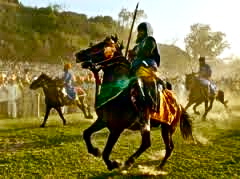 |
|
Celebrated at the Shrine of Keshgarh Sahib in Anandpur, Punjab |
|
Millions of People across India
Throng the Streets of Anandpur
To Witness the Celebration which was Conceived to Present the Strength
and Martial Arts Skills of Sikhs |
| Every year, first day of the lunar month Chet (first month of the
Nanakshahi calendar which governs the activities within Sikhism; mostly
coincides with March) marks the celebration of Hola Mohalla, a three-
seven day event. It was here in 1699 that the tenth Guru, Guru Gobind
Singh, baptized five men and founded the Khalsa Panth, which is the
modern day Sikh faith. Hola Mohalla was first celebrated at Anandpur in
February, 1701. |
|
People Travelling to Anandpur to Celebrate Hola
Mohalla |
|
Hola Mohalla hosts mock battles using swords and other
kinds of physical fights. Over the years, the festival grew bigger and
today, road side tents are set up miles before the main shrine where
people are provided with free food (langar) and shelter all day and
night. The main attraction, however, is the procession by Nihangas (a
distinctive order among the Sikhs), bareback horse-riding, and
performance of 'Gatka' (Sikh martial art).
There are Sikhs with massive and unique turbans holding a sword;
startling landscapes from Anandpur Sahib Railway station to the shrine,
buses over-loaded with passengers and streets full of people thrown into
revelry. |
|
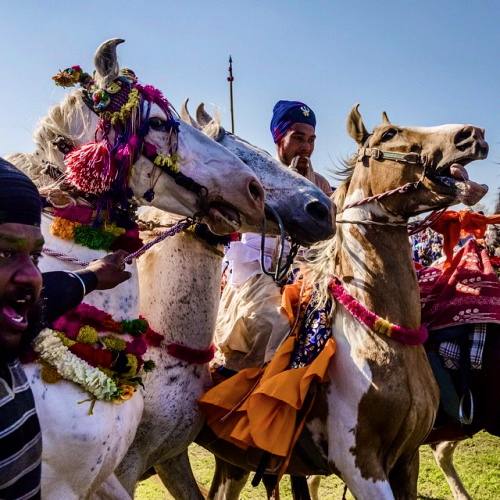 |
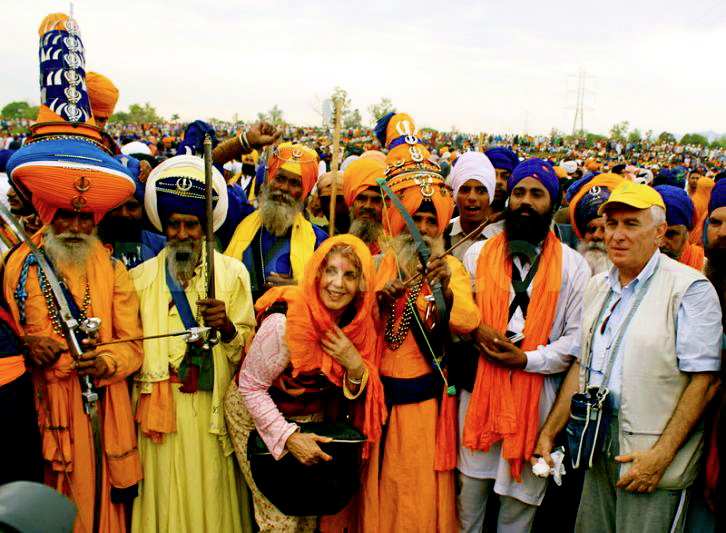 |
|
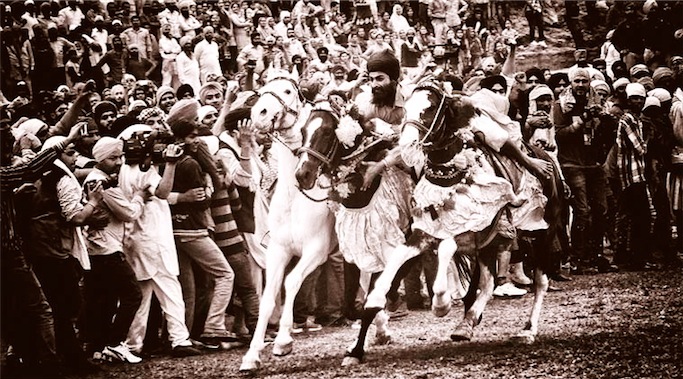 |
|
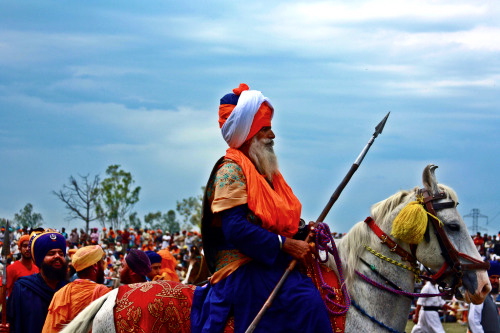 |
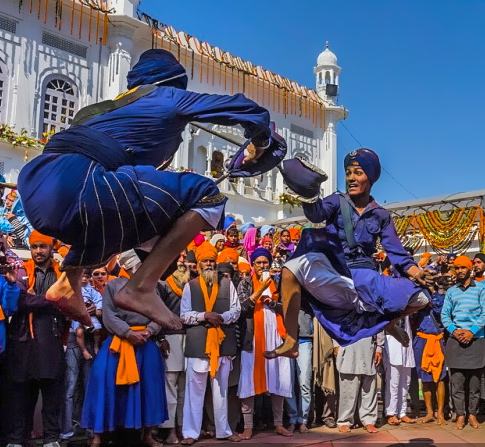 |
|
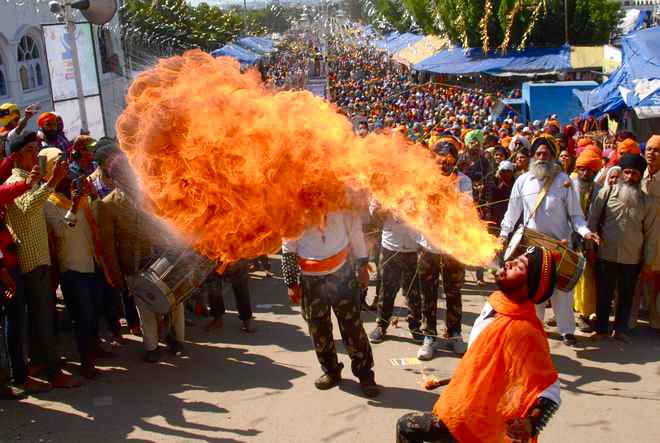 |
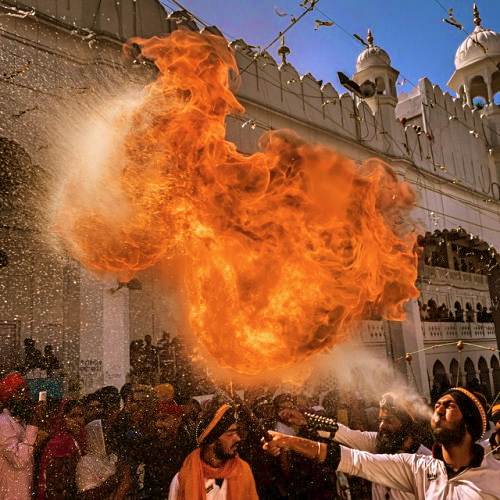 |
|
Ancient Text Proves Wrestling is Oldest Sport on Record
Wrestling has always been proud of it's ancient origins.
Now, wrestling has proof of its long history, as researchers at Columbia
University found an instructional manual on wrestling that dates back to
200 A.D. It was discovered in a dump in Egypt, and will now be kept at
Columbia. It is considered to be the oldest sports manual of any kind,
and the only document that relates to the original Olympic games. The
manual shows that wrestling hasn't changed much over the years.
Headlocks, underhooks, hand-fighting and how to fight out of a
hold, concepts that are still important to wrestlers today, are all
discussed. |
|
'Iron Mike' Tyson Promises Ip Man
Fans an Explosive Fight |
|
Reports say Ip Man 3 will be
Released in 3-D and Feature a Computer Generated Bruce Lee
No Convincing Actor could be found to Portray the Kung-Fu Icon
All Filming is being done on Location in Shanghai and at Hengdian World
Studios in Zhejiang Province - "Chinawood" |
|
February 2016
When the Latest Chapter in the Story of Ip Man, Bruce Lee's
Teacher, gets its Chinese Mainland Theatrical Release |
|
Cast Members of the Film "Ip Man 3" Pose During a
Press Conference in Shanghai China |
The $36 million action film, which will focus more on the
student-master relationship between Lee and Ip, may be the first of the
trilogy to hit the silver screen in North America in a big way,
especially with Tyson involved. The first two had an extremely limited
release in that market.
"Iron Mike" Tyson, who is reinventing himself as an actor, was
nursing a fractured finger in Shanghai on Friday
courtesy of some heavy sparring with lead star Donnie Yen on
the set of Ip Man 3. |
|
Mike Tyson's Finger Fractured by Donnie Yen |
Donnie Yen & Tyson |
"This is definitely going to be an exciting fight," said Tyson, 48.
"Me and him, it's a great clash, a great kamikaze kind of explosion."
"Most trilogies are never better than the first part. This one is going
to step up. A lot of drama, more realistic. It's real. Life on life's
terms," he told China Daily. |
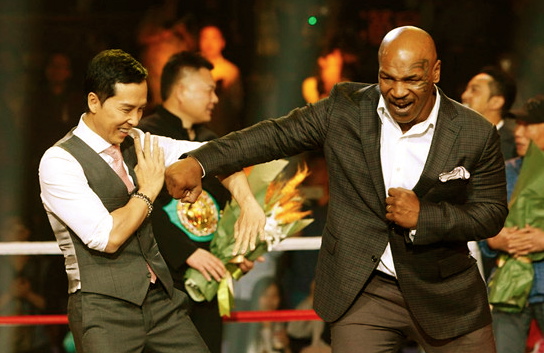 |
"I love being the bad guy," added the man known for his obliteration
of opponents in the ring in the 1980s, as he broke into a villainous
laugh. Tyson famously KO'd Michael Spinks in 91 seconds while at the
height of his powers.
In 1986 he became the youngest-ever undisputed heavyweight champion of
the world at the age of 20 years, four months and 22 days.
He earned a reported $300 million to $400 million during his career,
declared bankruptcy in 2003, and is now said to be worth around $1
million.
"Chinese culture can provide such great raw ingredients, but we lack
techniques and professionalism of production," the film director, Shi
said. "By learning from Hollywood, we can play a greater role on the
world stage and make our voices heard." |
|
Former "Heavy Weight World Champion"
Mike Tyson (R)
and Donnie Yen interact with each other during a press conference
|
|
|
Trailer Thousands of pupils matching red and black
sports uniforms kick, lunge and sprint across a concrete field and
towards the camera in a tightly-choreographed formation.
Of these nearly 35,000 students who practice martial arts at the Shao
Lin Tagou school, German director Inigo Westmeier’s documentary Dragon
Girls follows three. The three girls, all from poor Chinese provinces
and circumstances, attend, “so something will become of us.”
“If someone cries, the trainer doesn’t like that,” Xin, the youngest at
nine, explains, adding that sometimes she confuses being exhausted with
being ill, until she practices mind over matter. She is pragmatic about
her reasons for training – success and honour here will mean better work
prospects in the outside world. |
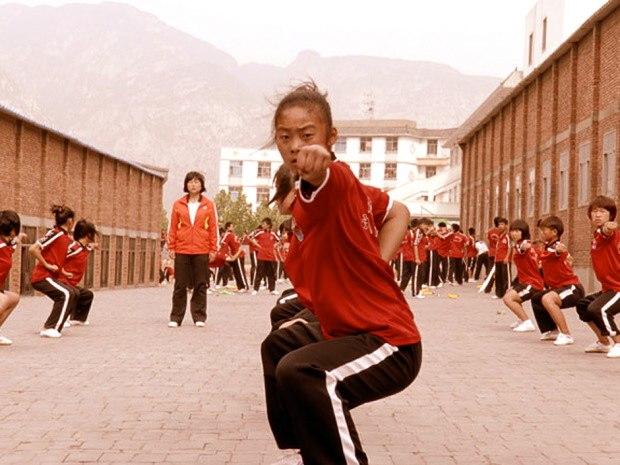 |
| The school’s neighbor is the Shaolin monastery, the birthplace of
Kung Fu. To a monk at the temple, the practice means inner wisdom and
liberation.
Presiding over the delicate ecosystem of vulnerability, pain and
hormones next door, the headmaster believes physical drills translate
into lasting gratitude and respect. The goal is to first “conquer their
thoughts and manners.”
While they’re technically still children, all three mourn a childhood
they haven’t been allowed – for them, it’s less a physical age than a
state of mind (and place: at home, with forgiving parents). “Mistakes
are not allowed.”
Westmeier uses these types of juxtapositions throughout, all without
passing judgment on the trainers, school or even parents. As one says,
they perhaps already work so hard they seldom have time to answer her
homesick phone calls, which is just as well. “If I cry, everyone at home
feels worse than I do.” |
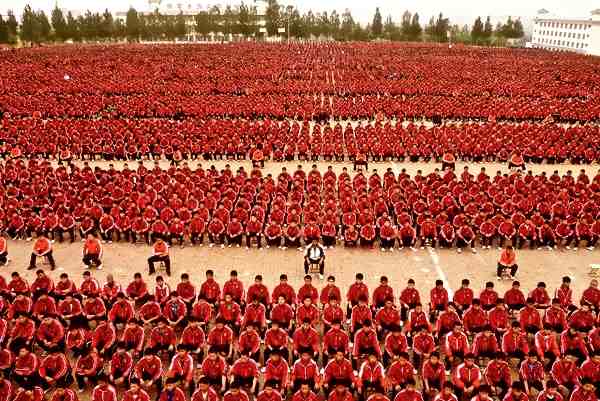 |
|
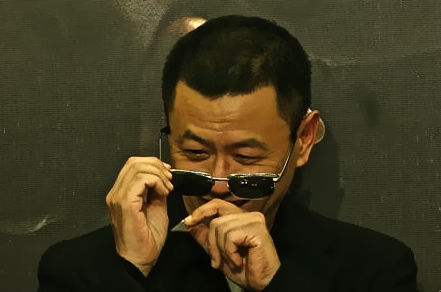 |
 |
|
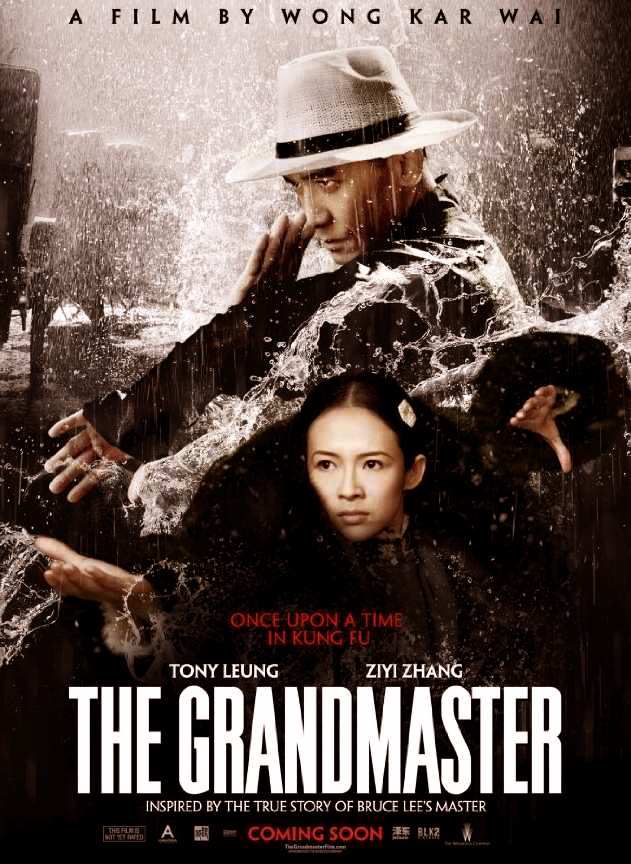 |
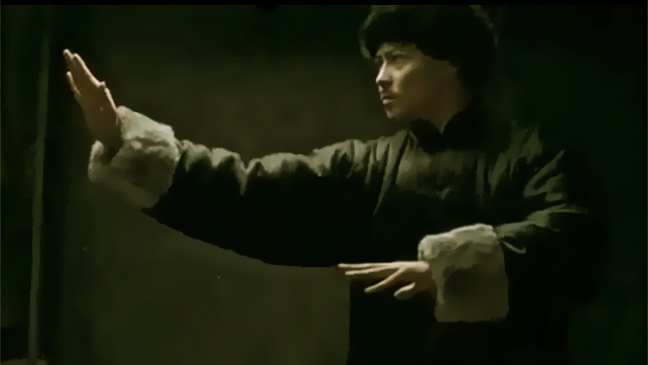 |
|
 |
|
Hong Kong auteur Wong Kar Wai exceeds expectations
with "The Grandmaster," fashioning a 1930s action saga into a refined
piece of commercial filmmaking. Boasting one of the most propulsive yet
ethereal realizations of authentic martial arts onscreen, as well as a
merging of physicality and philosophy not attained in Chinese cinema
since King Hu's masterpieces
Official US website:
http://thegrandmasterfilm.com
|
|
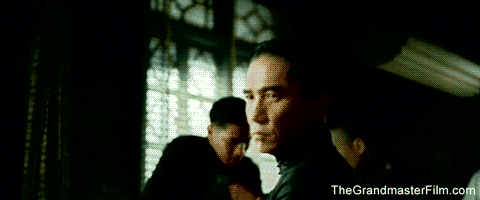 |
The fruit of eight years of labor and selected as the opening movie for
February's Berlin International Film Festival, The Grandmaster
tells the legendary tale of Bruce Lee's master Yip Man, played by Wong's
long-time collaborator and Cannes best actor award winner Tony Leung.
The idea kept brewing in his head and eventually took him on a
three-year journey, knocking on the doors of over 100 kung fu masters
across China."In the world of martial arts, there's a saying that
goes . . . |
'the skies outside and inside the door are different,' he said.
"In the world of martial arts, there are many people who are not
'masters', but they have a deep affection for martial arts. They always
hope to leave something behind for their clan and martial arts during
their lifetime," he said. "I think this spirit is the spirit that 'The
Grandmaster wants to convey -- lingering thoughts that are never
forgotten, echoes that will always come," Wong said.
Set at the infancy of modern China in the early 1900s, the retirement of
a martial arts guru leaves the title of Grandmaster up for grabs.
Among the four top fighters for the position is the feisty Gong Er,
played by Zhang Ziyi of Crouching Tiger, Hidden Dragon and Memoirs of a
Geisha.
For her role, Zhang trained under the teacher of kung fu star Jet Li,
and said the movements were key to expressing the spirit of the
characters. "She (Gong Er) is a combination of almost all the unique
features and merits of women of that era," Zhang said.
"In terms of movements, we trained for such a long time because the
director hoped when we went inside the world of the characters, we
already carried their spirit in our bodies." |
|